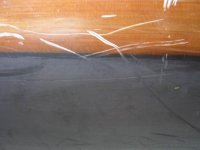- Joined
- Jun 30, 2014
- Messages
- 1,550
- Reaction score
- 282
Dacron is a little more fragile than #10 canvas so some sort of abrasion resistance would be good to have. I have no experience with Dacron but a lot with canvas. I dont have much trouble with rips punctures etc using canvas and traditional fillers. A friend here does use epoxy now on some canoes. I have thought about it but worry about cracking when the wooden part of the canoe flexes. Just using the wrong paint has caused me a lot of cracking in three canoe that we recanvassed, so I am loathe to try epoxy.
I would love to try Dacron. I worry about the loss of strength that it would impart to a fragile wooden hulll though. The hull and covering work together to compliment each other. Weakening either may not be a great idea. I sure would enjoy a bit lighter canoe though.
I do have some shellac here and was thinking of trying that but dont want to mess about on a canoe that is being sold. Same for using epoxy. We did try some test strips with epoxy a while ago and found that the first layer has to go on very light so as not to bleed through the canvas and bond with the hull. Second coat required. Since we use about 6 pounds of silica in a traditional filler I am not sure that is much of a weight savings to use epoxy. The big weight savings is the lightness of the Dacron if you use it instead of canvas. The epoxy test strips did crack when flexed off the backer boards but I was not really able to gauge this very well when they were installed on a wooden panel. I am mostly thinking that a twisting motion would be the biggest problem.
I know YC has a nice little Dacron covered canoe that she likes and has had a long time. Between her and Waterdog I have heard only good things. Most of the alleged issues are theoretical? I will have to compare the costs.
I would love to try Dacron. I worry about the loss of strength that it would impart to a fragile wooden hulll though. The hull and covering work together to compliment each other. Weakening either may not be a great idea. I sure would enjoy a bit lighter canoe though.
I do have some shellac here and was thinking of trying that but dont want to mess about on a canoe that is being sold. Same for using epoxy. We did try some test strips with epoxy a while ago and found that the first layer has to go on very light so as not to bleed through the canvas and bond with the hull. Second coat required. Since we use about 6 pounds of silica in a traditional filler I am not sure that is much of a weight savings to use epoxy. The big weight savings is the lightness of the Dacron if you use it instead of canvas. The epoxy test strips did crack when flexed off the backer boards but I was not really able to gauge this very well when they were installed on a wooden panel. I am mostly thinking that a twisting motion would be the biggest problem.
I know YC has a nice little Dacron covered canoe that she likes and has had a long time. Between her and Waterdog I have heard only good things. Most of the alleged issues are theoretical? I will have to compare the costs.

